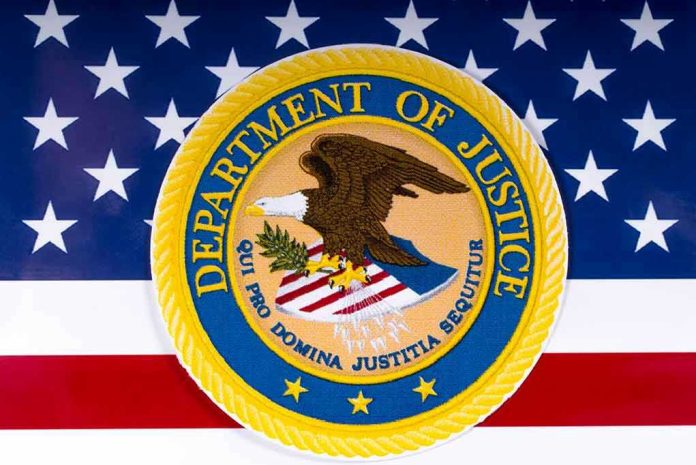
One digital daredevil’s $45,000 online bounty for the U.S. Attorney General detonated a federal firestorm, exposing the razor-thin line between free speech and criminal threat in America’s digital age.
Story Snapshot
- An online bounty targeting Attorney General Pam Bondi drew immediate FBI intervention
- Federal law treats online threats against public officials as serious crimes, even without explicit violence
- The episode highlights escalating risks for high-profile public servants in a polarized era
- Debates over free speech, digital accountability, and public safety are intensifying nationwide
When a Bounty Becomes a Federal Case
A post appeared online offering $45,000 for information leading to the whereabouts of U.S. Attorney General Pam Bondi. The sum—staggering by any standard—rocketed across social media, reverberating in activist circles and watchdog inboxes with a mix of disbelief and alarm. Within hours, the story had reached authorities, and within two days, the FBI was at the suspect’s door, warrant in hand. The agency’s rapid response underscored a new federal playbook: treat digital threats as imminent, actionable offenses, not empty internet bluster.
This Guy Thought It Would Be a Good Idea to Post a $45,000 Bounty on Pam Bondi – the FBI Disagreed https://t.co/7BLpztBvSy
— David Wedding (@hdwrench51) October 27, 2025
The suspect—whose identity remains sealed as the legal process unfolds—was arrested and charged with making threats against a federal official. The FBI and Department of Justice jointly announced the charges in early October, sending an unmistakable message: in the current climate, online provocations aimed at government leaders demand real-world consequences.
Pam Bondi’s Polarizing Profile and the Political Powder Keg
Pam Bondi’s rise to become America’s 87th Attorney General in February 2025 was anything but quiet. Known for her high-visibility crackdowns on opioid crime, human trafficking, and election law abuses, Bondi became an icon to some and a lightning rod to others. The attorney general’s assertive public persona has attracted both fervent supporters and vocal detractors, making her a potent symbol in a nation already primed for political confrontation. That notoriety, experts say, is precisely what puts officials like Bondi in online crosshairs.
Bondi’s office responded to the incident with a measured statement, thanking law enforcement for their prompt action and reiterating her commitment to serving without fear. The FBI, for its part, doubled down on its zero-tolerance policy toward threats, making clear that no amount of “just kidding” or crowdsourced ambiguity would shield perpetrators from prosecution. The message resonated across the political spectrum: the stakes for crossing the line are higher than ever.
Online Speech or Criminal Threat? Drawing the Legal Line
Legal experts point out that even without explicit calls for violence, offering a bounty for information on a public official can land squarely within the federal statutes designed to prevent intimidation and harm. The law—sharpened by years of precedent—recognizes that in today’s climate, the difference between a “prank” and a credible threat may hinge on context, not intent. The FBI’s swift investigation, enabled by cooperation from social media platforms, exemplifies a new era of digital forensics and coordinated federal response.
For the broader public, the case reignites debate over the First Amendment’s boundaries. Civil liberties advocates warn against overreach, cautioning that overly broad interpretations of threat statutes could chill legitimate dissent or whistleblowing. Law enforcement officials, meanwhile, argue that deterrence and vigilance remain the only bulwarks against escalating hostility toward public servants. The tension is palpable, with both sides agreeing only on this: the rules of engagement have changed.
The Ripple Effects: Security, Speech, and Silicon Valley’s Dilemma
Short-term, the incident has triggered a visible tightening of security around Bondi and other top officials, as federal agencies ramp up monitoring and threat assessment capabilities. Social media companies, already under intense scrutiny, face renewed calls to step up content moderation, accelerate law enforcement cooperation, and clarify policies on digital bounties and threats. For government watchdogs and free speech advocates, the case is a litmus test: will the pendulum swing toward safety or censorship?
Long-term, legal analysts predict a fresh wave of DOJ guidance and possibly new legislation tailored to the realities of online activism and digital intimidation. The costs—financial, social, and political—are mounting, but so too is the urgency to protect the rule of law in an era where a tweet or a post can spark a federal investigation. For now, the boundaries of online speech and the responsibilities of platforms remain deeply contested ground, with every new headline forcing Americans to ask: just how safe are our public officials in the age of the viral threat?
Sources:
United States Department of Justice






